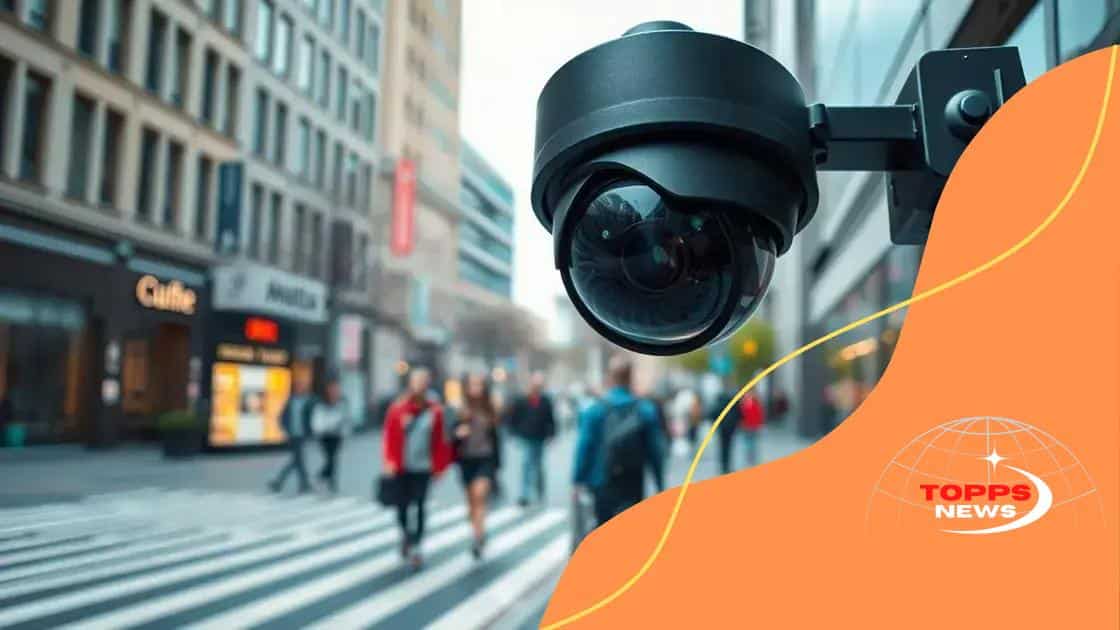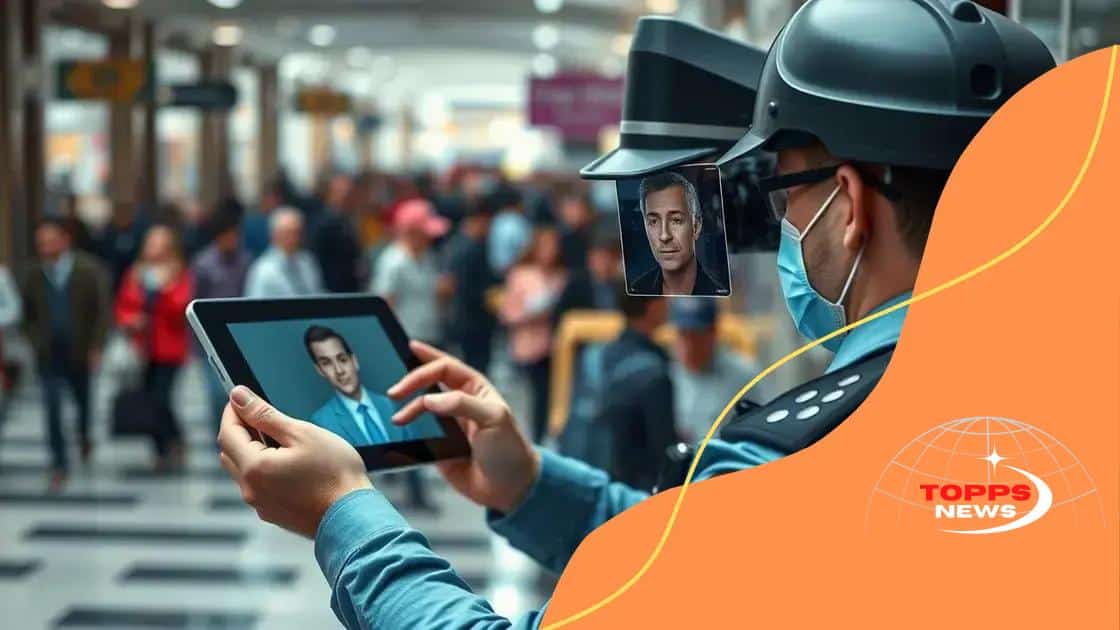The role of facial recognition in enhancing public safety

The role of facial recognition in enhancing public safety includes rapid identification of suspects, improved emergency response, and increased security measures, while also raising important privacy concerns that necessitate ethical oversight.
The role of facial recognition in enhancing public safety sparks a vital conversation about security technology. Ever wondered how it impacts your safety in public spaces? Let’s dive in.
Understanding facial recognition technology
The world of facial recognition technology is fascinating and complex. This technology enables systems to identify or verify individuals based on their facial features. By analyzing the unique characteristics of a face, facial recognition can provide significant benefits in various sectors.
How Facial Recognition Works
At its core, facial recognition technology uses algorithms to detect faces in images or videos. The process typically involves:
- Capturing an image of a person’s face
- Identifying key features, such as the distance between eyes and the shape of the jawline
- Encoding this information into a mathematical representation
- Comparing it with databases of known faces
This enables systems to swiftly match and recognize individuals, allowing for quicker and more accurate identification.
Applications of Facial Recognition
There are numerous applications of facial recognition technology. Some notable examples include:
- Security and surveillance in public spaces
- Access control for devices and buildings
- Personalized marketing based on demographic information
These applications demonstrate how facial recognition can enhance safety and improve user experiences in everyday life.
Furthermore, advancements in artificial intelligence are continually improving the accuracy and reliability of these systems. As we integrate more sophisticated algorithms, the potential uses for facial recognition technology will continue to grow.
However, it’s essential to balance the advantages with considerations regarding privacy and ethical use. As we embrace this technology, being aware of its implications is crucial. By fostering a responsible approach to its deployment, we can capitalize on the benefits while minimizing risks.
How facial recognition works
Understanding how facial recognition works is key to appreciating its impact on our lives. This technology employs complex algorithms to analyze facial features and identify individuals. It captures an image, analyzes unique characteristics, and matches these with known faces.
Key Steps in Facial Recognition
The process of facial recognition involves several essential steps:
- Image capture: Cameras capture images of faces in various environments.
- Feature extraction: The system identifies and measures key facial landmarks, like the distance between the eyes.
- Encoding: The facial features are converted into a numerical format for comparison.
- Matching: The encoded face is compared against a database of known faces to find a match.
This systematic approach allows for quick and accurate identification. For instance, law enforcement can leverage facial recognition to identify suspects during investigations, enhancing public safety.
Technology Behind Facial Recognition
Facial recognition relies on various technological advancements. Machine learning algorithms train systems to improve identification accuracy. This results in less error and higher reliability in recognizing faces.
Another crucial element is the use of 3D modeling, which helps in identifying faces from different angles, making the technology more robust. By combining these methods, facial recognition continues to evolve and adapt.
As this technology integrates into our daily lives, its applications can be seen in security systems, personal devices, and even social media platforms. This widespread use emphasizes the importance of understanding how facial recognition works, especially as society becomes more dependent on these systems.
Benefits of facial recognition in public safety

The benefits of facial recognition in public safety are significant and multifaceted. This technology plays a crucial role in enhancing the security of communities by enabling faster responses to threats.
Immediate Identification
One of the most vital advantages is the ability to identify individuals quickly. Law enforcement agencies can use facial recognition to recognize suspects in real time, helping to prevent crimes before they happen.
- Rapid response: Officers can respond quickly when they have instant information about potential threats.
- Increased accuracy: Modern systems reduce the chances of misidentification, enhancing overall reliability.
- Convenient integration: Security cameras in public spaces can connect to databases to provide immediate alerts.
This integration improves situational awareness and bolsters law enforcement’s effectiveness. Furthermore, it enhances public safety by deterring criminal activities in visible areas.
Enhanced Crime Prevention
Facial recognition technology contributes significantly to crime prevention efforts. Regular monitoring of high-traffic areas can lead to a noticeable decrease in criminal activities. When potential offenders know they are being watched, they may think twice before acting.
Additionally, facial recognition systems can help authorities track repeat offenders or individuals on watchlists. By identifying these individuals quickly, law enforcement can intervene as necessary, reducing the risk of further offenses.
Streamlined Investigations
The integration of facial recognition into investigative processes allows for more efficient case resolutions. Detectives can sift through large databases of images or footage faster than ever. This efficiency can lead to solving cases that may have remained cold otherwise.
For example, after a robbery, detectives can analyze surveillance footage to identify suspects, vastly improving the effectiveness of their investigations. By using facial recognition, officers can focus their efforts where they matter most.
Privacy concerns related to facial recognition
Privacy concerns related to facial recognition technology have become a hot topic in recent years. As this technology becomes more prevalent, many people worry about how their personal information is being used and protected.
Data Collection and Storage
One major concern is the data collection process. Many facial recognition systems require extensive databases that include images of individuals. This raises questions about how this data is collected and stored.
- Consent: Are individuals aware that their data is being collected?
- Data security: How is this sensitive information being protected from breaches?
- Retention policies: How long is the data kept, and who has access to it?
Without clear policies and protections, there’s a risk that personal data could be misused.
Potential for Misidentification
Another significant issue is the potential for misidentification. Facial recognition technology is not foolproof. Mistakes can happen, leading to wrongful accusations or detentions. This is especially problematic in law enforcement.
When systems incorrectly identify someone, it can result in unjust consequences. For instance, a person might be wrongfully arrested based on a faulty identification. These errors can lead to a lack of trust in public safety systems.
Surveillance and Public Spaces
The rise of facial recognition technology has led to increased surveillance in public areas. Some argue that this creates a “Big Brother” scenario where people feel constantly watched. The feeling of being monitored can change behavior, leading to a chilling effect on personal freedoms.
Communities need to discuss how facial recognition impacts civil liberties. Finding a balance between safety and personal privacy is crucial as technology continues to evolve.
Future of facial recognition in law enforcement
The future of facial recognition in law enforcement looks promising, with advancements continually reshaping how police and security agencies operate. As technology evolves, so do the opportunities for improving public safety.
Advanced Algorithms
One exciting development is the improvement in algorithms used for facial recognition. These algorithms are becoming more sophisticated, allowing for faster and more accurate identifications. With machine learning and artificial intelligence, systems can learn from mistakes, reducing misidentification rates over time.
- Real-time data analysis: Law enforcement can analyze data from surveillance cameras almost instantly.
- Enhanced security measures: The technology will become integral in protecting public spaces.
- Broader applications: Beyond criminal identification, it may help in community engagement and proactive policing.
This means officers can react more swiftly when problems arise, potentially preventing crimes before they occur.
Integration with Other Technologies
The integration of facial recognition with other technology, such as drones and body cameras, is likely to enhance its effectiveness. For example, drones equipped with facial recognition may provide aerial surveillance for events, improving crowd management and security.
Body cameras that utilize facial recognition can help officers document interactions while ensuring accountability.
Oversight and Regulation
As the role of facial recognition grows, so too will the need for oversight and regulation. Balancing technological advancements with privacy rights will be crucial. Policymakers must work to create laws that ensure ethical usage.
Transparency in how facial recognition is implemented can build public trust while addressing concerns about potential misuse. The dialogue between law enforcement and communities will shape the technology’s trajectory.
Overall, the future of facial recognition in law enforcement holds the potential for significant changes in how safety is managed. Continuous advancements, integration with new technologies, and strong oversight can position it as a vital tool in enhancing public safety.
In conclusion, the role of facial recognition in enhancing public safety is both significant and complex. As technology advances, we can expect improvements in accuracy and integration with other systems, which will help law enforcement respond more effectively to threats. However, it is crucial to balance these advancements with the need for privacy and ethical considerations. Engaging in open discussions about the use of this technology will be key to ensuring its beneficial application in our communities. Emphasizing the importance of oversight and regulation will also help maintain public trust and safety.
FAQ – Frequently Asked Questions about Facial Recognition in Public Safety
What are the main benefits of facial recognition in law enforcement?
The main benefits include immediate identification of suspects, enhanced security measures, and improved efficiency in investigations.
Are there privacy concerns related to facial recognition technology?
Yes, privacy concerns include data collection, retention policies, and the potential for misidentification.
How can facial recognition enhance public safety?
Facial recognition can improve surveillance, help prevent crimes, and enable quicker responses in emergencies.
What role does oversight play in the use of facial recognition?
Oversight ensures that facial recognition is used ethically, maintaining public trust and protecting individual privacy rights.





